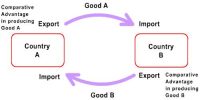Balance of payment is the record value of all the transaction between a countries residence and all the rest of the world. It reflects a clear picture of the economy and provides a holistic picture.
In short Balance of payments of a country is the annual record of economic relations of the country with the rest of the world. It gives the details of foreign exchange received or foreign exchange spends on various accounts.
Measures to Correct Disequilibrium in Balance of Payment –
The disequilibrium of the balance of payments can be corrected in three ways.
(A) Export-Led Growth: Export plays an important role in the growth of the economy. It is regarded as a key factor in economic development.
Promotion of Labor-Intensive Industries: Promotion of labor-intensive industries should be established because in such countries labor is cheaper. The cheap labor can give a comparative advantage in the production and export of commodities. The export earnings, therefore can increase and help in restoring equilibrium in the balance of payment problem.
- Diversification of exports
The developing countries have been showing a heavy concentration on a few primary commodities. If there is a recession in the international market for cotton and rice of Nature is not kind, the production declines and exports are greatly reduced and have a damaging effect on the balance of payments. They should, therefore, diversify their exports and produce value-added goods for gaining competitive strength in the international market. The government should manage foreign exchange by ordering all exporters to surrender their foreign exchange to the central bank and then ration out among licensed importers.
- Development of Industries having a low capital-output ratio
Developing countries with low foreign exchange earning cannot afford to import heavy machinery. If they like Korea, Taiwan, Hong Kong, Singapore, take tip lines of production having a low capital-output ratio it can lead to fast-growing export.
- The decrease in Consumption
In spite of the rapid rise in prices, there is a greater increase in the national consumption of developing countries. The higher consumption of locally manufactured goods is reducing the exportable surplus and consequently the foreign earning to them. The people should be motivated to adopt simple living and austerity for bridging the resource gap.
- Reduction in export duties
Reduction in export duties, publicity of locally manufactured goods in the foreign markets, adequate provision of credit to the private sector for the development of industries, etc earn greatly help in increasing export earnings and relieving the pressure on the balance of payments.
- High-quality goods
In order to capture foreign markets, it is necessary that high-quality goods at a minimum cost should be produced.
- Pricing of goods
For increasing exports, it is necessary that goods should produce under optimal conditions and offered a competitive price in the international market.
- Packing
For promoting exports, high-quality packing is essential. If packing is not attractive and durable it will not capture foreign markets.
- Creation of export agency
For a breakthrough in exports, export agencies should be created in the private sector.
- Joint Venture
The exports can also be pushed up by establishing industries with joint ventures of foreign investors. The producers of these industries can be sold in the foreign markets and the country can earn sizeable foreign exchange.
(B) Reduction in Imports: In order to correct disequilibrium in the balance of payment, the governments of developing countries should reduce the import of consumer goods. Similarly, the raw material which can be produced in the country at a cheaper cost should not be imported. At the same time, imports should be discouraged by undertaking import substitution and imposing reasonable tariffs. The decline in imports of consumer goods and industrial ‘raw material can greatly reduce the deficit gap.
(C) Reduction in Invisible Imports: The payments on invisible imports like shipping, insurance, banking, services, payments of technocrat working in various establishments, expenses on diplomats, etc are on increase in developing countries. These payments should be curtailed down.















